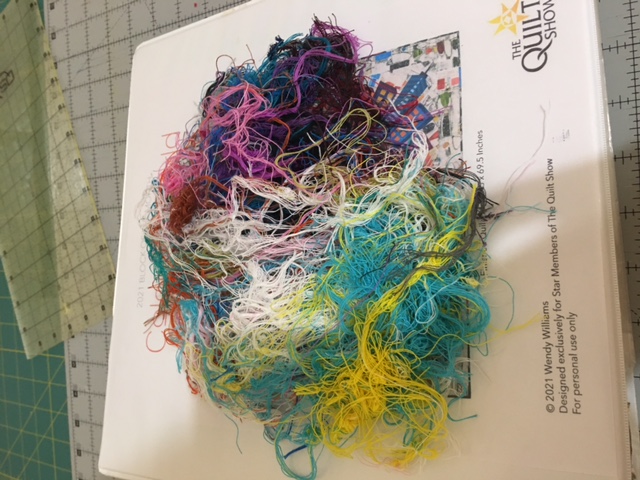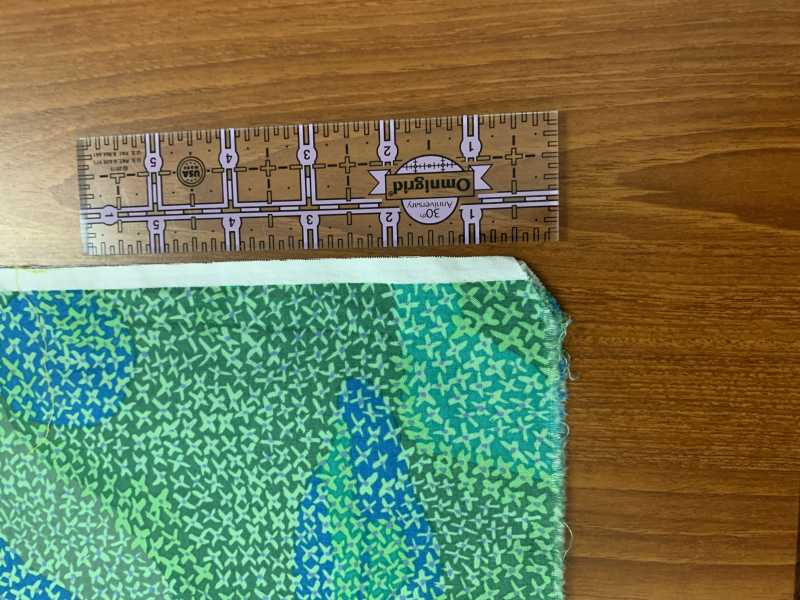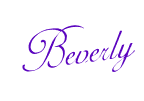Announcement
Collapse
No announcement yet.
[vb_side_1]
Latest Forum Posts
Collapse
-
by gjordanI’m trying to learn how to load photos. ...
-
Channel: BOM 2021 - Color My World
03-25-2021, 09:17 PM -
-
I am late to the party so I have only completed the 8 Small House 1 units so far. I realize this post is too late for everyone...
-
Channel: BOM 2021 - Color My World
03-24-2021, 11:30 AM -
-
by HelenWMost Color My World quilters probably think of you as the trouble shooter for all thing Color My World.
They may not...-
Channel: BOM 2021 - Color My World
03-23-2021, 06:47 AM -
-
I moved the first of the year but I had ordered the fabric kit. Now when I opened it i didnt find any directions or the...
-
Channel: BOM 2021 - Color My World
03-22-2021, 12:38 PM -
-
by midnight33I’m jumping ahead a bit....made brown fusible bias for tree trunks & now experimenting with dif shapes & fabrics...1 Photo
-
Channel: BOM 2021 - Color My World
03-21-2021, 05:37 PM -
-
by nhbasketsThought I’d start a thread where those of us using wool can post on progress when using this alternative medium for this...2 Photos
-
Channel: BOM 2021 - Color My World
03-19-2021, 04:31 PM -
-
Because I am using a dark background I plan to make lighter coloured trees. I know that the 14 yards of bias tape required...
-
Channel: BOM 2021 - Color My World
03-17-2021, 07:39 PM -
-
I can't find anything that mentions about what kind/size needle that is recommended if sewing with 60 wt thread on top and...
-
Channel: BOM 2021 - Color My World
03-14-2021, 08:04 PM -
Trending Forum Posts
Collapse
-
by gjordanI’m trying to learn how to load photos. ...
-
Channel: BOM 2021 - Color My World
03-25-2021, 09:17 PM -
-
I am late to the party so I have only completed the 8 Small House 1 units so far. I realize this post is too late for everyone...
-
Channel: BOM 2021 - Color My World
03-24-2021, 11:30 AM -
-
by HelenWMost Color My World quilters probably think of you as the trouble shooter for all thing Color My World.
They may not...-
Channel: BOM 2021 - Color My World
03-23-2021, 06:47 AM -
-
I moved the first of the year but I had ordered the fabric kit. Now when I opened it i didnt find any directions or the...
-
Channel: BOM 2021 - Color My World
03-22-2021, 12:38 PM -
-
by midnight33I’m jumping ahead a bit....made brown fusible bias for tree trunks & now experimenting with dif shapes & fabrics...1 Photo
-
Channel: BOM 2021 - Color My World
03-21-2021, 05:37 PM -
-
by nhbasketsThought I’d start a thread where those of us using wool can post on progress when using this alternative medium for this...2 Photos
-
Channel: BOM 2021 - Color My World
03-19-2021, 04:31 PM -
-
Because I am using a dark background I plan to make lighter coloured trees. I know that the 14 yards of bias tape required...
-
Channel: BOM 2021 - Color My World
03-17-2021, 07:39 PM -
-
I can't find anything that mentions about what kind/size needle that is recommended if sewing with 60 wt thread on top and...
-
Channel: BOM 2021 - Color My World
03-14-2021, 08:04 PM -
[vb_side_2]
[vb_main_1]
Washing fabric
Collapse
X
-
-
-
-
Filter
-
Administrative
new posts
-
Washing fabric

I washed the fabric from the kit today, per Barbara's instructions. I would have washed it anyway, unless Barbara said not to. Be prepared to clip of millions of threads! I'm guessing that we shouldn't starch the fabric if we plan to use freezer paper. Is that right? First time posting on this forum, so I'm not sure the picture will show up or not.Tags: None
- IP
-

Lizzybelle, photo came out great.
Yes, it is recommended you wash the fabric first. To cut down on raveling, I always clip a 1/4-1/2" diagonal cut on all four corners before washing. This helps lessen the raveling AND I can tell at a glance if the fabric has been washed already.
I would say don't starch because we are using Freezer paper but if you must starch, use a light touch.
https://bbquiltmaker.blogspot.com
North Alabama, USA
"I am a part of all that I have met" A. Lord Tennyson
- IP
-
When piecing very small units, like 2.25” nine patches, starch can really help. When paper piecing, either with freezer paper or newsprint, I don’t find the need for starch to stiffen the fabric. The paper provides stability while creating the buildings.
https://bbquiltmaker.blogspot.com
North Alabama, USA
"I am a part of all that I have met" A. Lord Tennyson
- IP
Comment
-
Did you watch the pre-wash video? I separate darks and lights, this was mentioned at 1:20 in the 4 minute video.
https://thequiltshow.com/learn/classrooms/category/latest/bom-2021-color-my-world-by-wendy-williams
https://bbquiltmaker.blogspot.com
North Alabama, USA
"I am a part of all that I have met" A. Lord Tennyson
- IP
Comment
-
People who are committed to pre-washing do it for a few reasons:
Remove excess dye from fabric
Remove sizing used in manufacturing, so fabric is softer and less irritating to sensitive skin
Allow for any shrinkage before fabric is cut and sewn
To be sure fabric is clean at the beginning
I don’t subscribe to any of those theories mostly. I pre-wash the Kit fabrics sold by TQS so I can see what might happen for others. As the photo of tangled threads shows, reminding people of the cut across the ends trick was a helpful thing to share.
Just because you don’t plan to wash your wall quilt, eventually it will belong to someone else who could wash it. Just a thought.
Anyone else who routinely pre-washes fabric please chime in here.
https://bbquiltmaker.blogspot.com
North Alabama, USA
"I am a part of all that I have met" A. Lord Tennyson
- IP
Comment
-
I prewash all of my fabric because I don't like the feel of the sizing that comes in the fabric on the bolt. I also feel like I can get my cuts closer to on-grain after washing. The sizing that they use on the bolt makes the fabric look crisp and nice, but it usually distorts the fabric away from the grain. You can see this best by looking at a panel from a bolt. Panels are notorious for not being "straight" and so are difficult to deal with. But the fabric printing process always prints panels on grain, so it is the sizing on the bolt that is distorting them. It's subtle, but the more you can get the pieces in your quilt to have the grain running perfectly vertical, the better your quilt will hang.Originally posted by "Mytime" post=151802You said in the video you were pre washing because it was a kit. I am not using the kit, will use the quilt as a wall hanging and do not plan to wash it when it is completed, what is the advantage to pre washing the fabric?
- IP
Comment
-
I wash every piece of fabric I bring home - whether for a wall quilt or larger, to get out any chemicals. It's washed with color catchers and dried before it makes it to my sewing room. Just my personal preference. If it's questionable colors, I wash it until the color catchers are white. Just my personal preference.
- IP
Comment
-
A few more tips for pre-washing fabric (I have been pre-washing my fabric for thirty years - new fabric goes right into the laundry room):
Yes! as Barbara says, cut those corners!
For commercially dyed fabrics, I started buying Synthropol (which removes un-attached dye from the fabric), but now I use Retayne (which tries to attach un-attached dye to the fabric) (I purchase mine from Dharma Trading online but you can purchase it other places also). Especially if it is a dark color and you suspect it will run, the Retayne helps to keep the color. I do still use the Synthropol for my hand-dyed fabrics.
I have a quite large washer and dryer but limit my pre-wash loads to 5-7 yards.
I do separate colors / light and darks / and by size - washing smaller pieces with yardage beats up the smaller pieces and in the dryer they tend to get wrapped up in the larger pieces and do not dry well.
If it is a long quarter yard or smaller than a quarter yard, I use lingerie and sweater bags meant for washing these delicate items in the washing machine. I find that they help reduce the fraying and with the long quarter yards, they tend to twist on themselves so much and putting them in the bags helps a little. I do combine smaller pieces in one bag, but how much I put in depends on the size of the bag - I don't overload the bag though. My bags are polyester so they don't really pick up any colors, but when they begin to become dingy, I throw them in with a bleach load of laundry.
I also use hot water and the most delicate cycle on my machine which allows hot water (beware because my 'hand-wash cycle' only uses cold no matter what I have set so you may want to check for that).
After drying, I do iron my fabric - I find ironing the fabric such a wonderful process. It gives me time to fall in love with the fabric again !
!
- IP
Comment
-
Great tips about washing fabrics from Micheleinla for those who want to pre-wash.
In case you haven't looked at bolts of fabric lately in a real quilt shop, many of the manufacturers now say "Machine Wash Cold"--this is printed on the end of the cardboard bolts.
https://bbquiltmaker.blogspot.com
North Alabama, USA
"I am a part of all that I have met" A. Lord Tennyson
- IP
Comment
-
I straighten the grain and prewash yardage because I don't want it to shrink or bleed after putting a lot of work and money into a project. I have had bad experiences with both.
Remember the TQS triangle exchange project? Right now I am dealing with a purple bleeding triangle in the quilt I made with those triangle squares. The purple bled into it the cream triangles all around it. This is an important quilt for me, because it has Alex Anderson's and Ricky Tim's signatures on it. I did not wash it. I do not plan to wash it. It bled somehow regardless.
I make both art quilts, and washable bed quilts.
I straighten yardage which I might use for border or backing. I learned to pull a thread in my clothing construction courses to find the true crosswise grain. I use that pulled thread line as a guide to serge the edge. It takes a few minutes to pull the thread, but the serging takes almost no time at all. Sergers are fast. Then I prewash it with similar colored fabrics and color catchers. I dry it on hot, to preshrink it. My dryer has a setting to "damp dry" fabrics so I can take them out while still slightly damp to press. It also helps to set the dryer to tumble them for awhile afterwards to keep wrinkles from setting.
I get no raveled or loose threads. The fabric is "on grain" when I take it out of the dryer. However, it may have gotten twisted or skewed rolling around in the washer and dryer. I pull it back into shape to square it up before pressing it and folding it to store.
I cut from one end only. The other serged end tells me that fabric is prewashed and safe to use.
I have found that straightening the grain first makes it much easier to get a quilt that is squared up and hangs straight - whether it is a wall hanging or a bed quilt.
I serge and prewash fat quarters too, but I don't straighten the grain on them first. No need to.
I bought a few bundles of reproduction 10" squares for my Afternoon Delight. I found that they all shrunk significantly in one direction - regardless of the manufacturer. (I am still working on my Afternoon Delight.) I have enjoyed experimenting with different applique methods here.)
Long skinny fabrics can twist together in the washer and dryer. I sometimes serge long skinny fabrics of similar colors together, along the long side, to make a large piece of fabric that won't twist together. After pressing it, I can quickly rotary cut them apart along joined serged seam. I only lose about 1/4" of fabric under the serged edge, and have no raveled threads to trim.
I test suspicious fabrics by ironing them wet between two pieces of white cotton with a steam iron.
I like Synthrapol too. It doesn't take much.
I have used Retayne also on fabrics that continue and continue to bleed regardless of how many times they have been prewashed. However, I don't like the way fabrics feel after being treated with Retayne. Retayne must be used at 140*, at least. I read that fabrics treated with Retayne can lose their Retayne protection if washed later in water that is warmer than the temperature of the water it was treated with Retayne, or the fabric loses that Retayne coating.
I usually decide that fabric is not worth fooling with and toss it in the ragbag.
I have used Retayne on commercial clothing that bleeds badly the first time I washed it. I am thinking of a red sweatshirt in particular that my son really likes. The Retayne worked pretty well to control the bleed on that.
- IP
Comment
-
I second Barbara comment that starch MAY create a problem in that the fabric won't stick to the freezer paper. If you must starch use a light hand, and do a test on a small piece of fabric and the freezer paper you are using. If the fabric won't stick to the freezer paper the culprit is probably the starch. Best Press will have the same effect of starch of not sticking to the freezer paper (found this out the hard way)
- IP
Comment
What's Going On
Collapse
There are currently 35 users online. 0 members and 35 guests.
Most users ever online was 4,446 at 07:08 AM on 07-28-2025.
Forum Stats
Collapse
Topics: 7,646
Posts: 144,737
Members: 16,641
Active Members: 5
Welcome to our newest member, Lev Anderson-LevTest1.
Latest Topics
Collapse
There are no results that meet this criteria.
Trending
Collapse
-
by d.t.whitemanAnyone paper piecing instead of using freezer paper? What do you think?
-
Channel: BOM 2021 - Color My World
03-04-2021, 08:51 PM -
-
by bbquiltmakerPlease use this Topic to SHOW AND TELL your Mariner's Compass block!
-
Channel: BOM 2021 - Color My World
01-25-2021, 01:49 PM -
-
Small Houses 3 and 4 are here. BE SURE to WATCH the VIDEO BEFORE CUTTING anything. Some of the pieces are small--I increase...
-
Channel: BOM 2021 - Color My World
03-01-2021, 08:14 AM -
-
by gjordanI’m trying to learn how to load photos. ...
-
Channel: BOM 2021 - Color My World
03-25-2021, 09:17 PM -

Comment